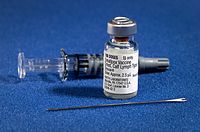
Photo from wikipedia
Monkeypox is an emerging infectious disease for which outbreak frequency and expected outbreak size in human populations have steadily increased.1 The geographic spread of monkeypox cases has expanded beyond the… Click to show full abstract
Monkeypox is an emerging infectious disease for which outbreak frequency and expected outbreak size in human populations have steadily increased.1 The geographic spread of monkeypox cases has expanded beyond the forests of central Africa, where cases were initially found, to other parts of the world, where cases have been imported. This transmission pattern is likely due to the worldwide decline in orthopoxvirus immunity, following cessation of smallpox vaccination, once smallpox was declared eradicated in 1980. Monkeypox could therefore emerge as the most important orthopoxvirus infection in humans.2 We use mathematical modelling to argue that, in a population with diminishing herd immunity against orthopoxvirus species, the epidemic potential of monkeypox will continue increasing. Monkeypox is caused by the monkeypox virus, member of the orthopoxvirus genus in the Poxviridae family. This genus includes three other human pathogens: variola virus (causing smallpox), cowpox virus and vaccinia virus. Monkeypox and smallpox yield similar clinical presentations, with monkeypox causing lymphadenopathy, as a distinguishing feature, early in the disease course.2 Smallpox infection leads to long-lasting immunity; repeat attack rates of smallpox are just about 1 in 1000 for 15–20 years.3 Smallpox vaccination with vaccinia, a first-generation vaccine, also yields long-lasting immunity, with an efficacy of 80–95%. The current recommendation for revaccination is every 10 years, although longitudinal studies suggest that protection may last much longer.4 Vaccinia is also known to deliver long-lasting immunity against monkeypox, with 85% efficacy.5 Furthermore, studies of antibody responses to orthopoxvirus species suggest perfect cross-immunity between smallpox and monkeypox. No concurrent epidemics of smallpox and monkeypox have ever been reported. Smallpox is known to be a human-only disease, while monkeypox is a zoonotic disease, whereby introductions in human populations take place from a currently unidentified animal reservoir. In particular, contacts with animal species in forests of western and central Africa, notably Central African Republic, Democratic Republic of the Congo, Nigeria and Republic of the Congo, result in sporadic monkeypox introductions into human populations. All monkeypox outbreaks were self-limiting, with human transmission chains ending without establishing epidemics.2 With the eradication of smallpox, monkeypox appears to emerge as the dominant pox disease in humans. Currently, the epidemic risk for humans is considered to be small.6 The reproduction number, denoted by R, is often used to quantify the ability of an emerging disease to invade a population. R is defined as the expected number of secondary infections per primary infection, whereby the basic reproduction number, R0, refers to the context of a fully susceptible population. When R is above 1, epidemic potential has been reached. An R0 above 1 indicates that the disease has epidemic potential. Mathematical modelling of smallpox transmission7 often invokes the simplifying assumption that smallpox infection or vaccination yields perfect, lifelong immunity. The same assumption may hold for monkeypox, for which much less is known about infection. The theory of transmission of infectious diseases with perfect cross-immunity shows that, between two infectious diseases competing to infect susceptible hosts, the disease with the larger R0 prevails, while the other is eliminated. The R0 for smallpox has previously been estimated between 3.5 and 6.0;7 hence, theoretically, R0 for monkeypox must be smaller. Furthermore, the theory emphasizes the critical role of the animal reservoir for the persistence of monkeypox. In the case where herd immunity is induced through vaccination at birth, with a vaccine delivering perfect, lifelong immunity, which only takes in a fraction ε of those vaccinated (ε is called vaccine efficacy), R and R0 are related by the following equation: R = R0 (1-εp), where p is the vaccination coverage and εp is the effective vaccination coverage. We performed analyses of the transmission potential for both smallpox and monkeypox, using data collected in the Democratic Republic of the Congo during 1966–1984. Smallpox vaccination in this country ended in 1980, with vaccination coverage of nearly 100%. Assuming that R0 for smallpox was 3.5–6.0,7 and vaccine efficacy was 80–95%,3 we estimated R for smallpox at 0.59 (uncertainty bounds 0.18–1.2), consistent with the epidemiological observation of no smallpox cases in the country beyond 1980. Data collected in the Democratic Republic of the Congo during 1980–19845,8 show that R for the Congo basin clade of monkeypox at that time was 0.32 (uncertainty bounds 0.22–0.40).9 This result is consistent with the epidemiological observation that monkeypox transmission among humans in the country was not selfsustained.5,8 However, using 85% for vaccinia efficacy (meaning effective coverage) against monkeypox1 and the above equation, we calculated R0 for monkeypox to be 2.13 (uncertainty bounds 1.46–2.67), smaller than R0 for smallpox, but larger than 1. We therefore postulate that monkeypox had epidemic potential in the Democratic Republic of the Congo in the early 1980s. According to our model, a monkeypox epidemic could not have started in this country between 1980 and 1984, since 85% of the population was immune to monkeypox; monkeypox was observed as a rare disease in humans, occurring only sporadically. Since then, the Democratic Republic of the Congo has reported increased monkeypox human infections1 and parts of the country have been declared monkeypox-endemic areas.1,2 In 2011–2012, the population immunity against orthopoxvirus species was only 60% (95% confidence interval, CI: 53–65%);10 that is, 96% (95% CI: Modelling human-to-human transmission of monkeypox Rebecca Grant, Liem-Binh Luong Nguyen & Romulus Breban
Journal Title: Bulletin of the World Health Organization
Year Published: 2020
Link to full text (if available)
Share on Social Media: Sign Up to like & get
recommendations!